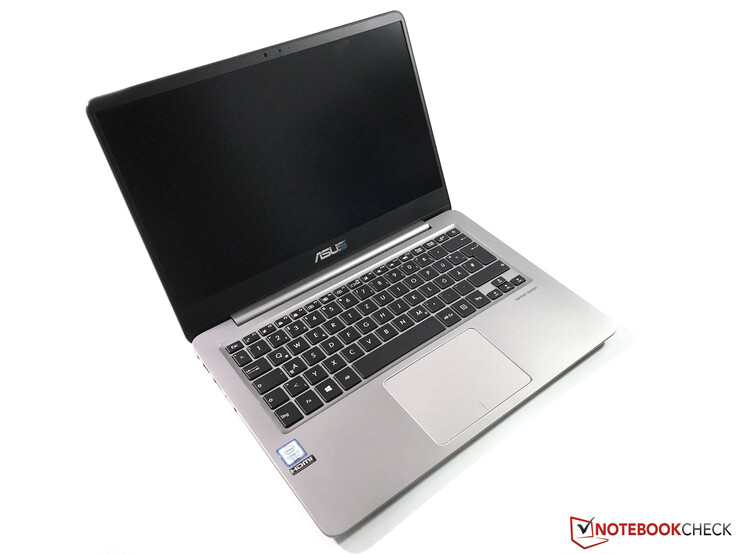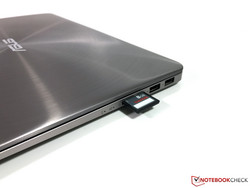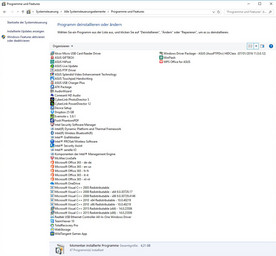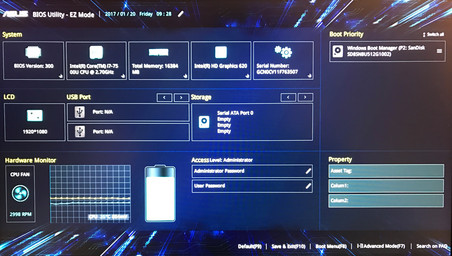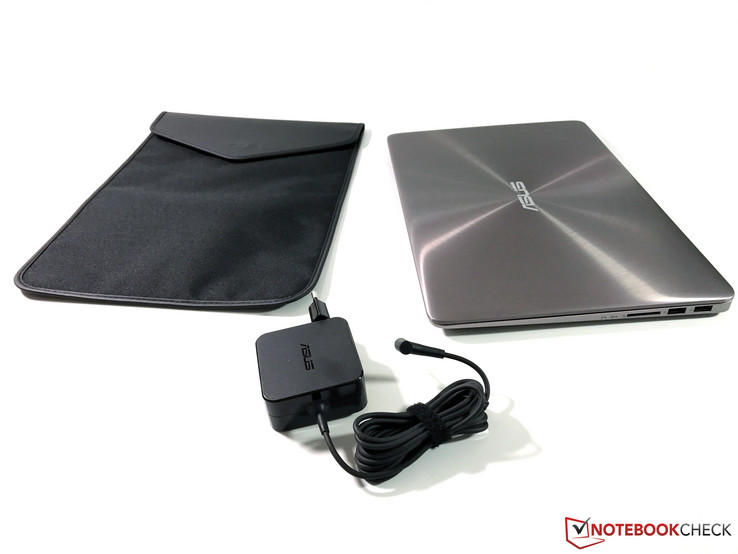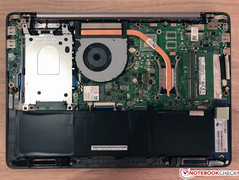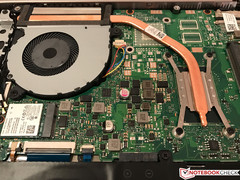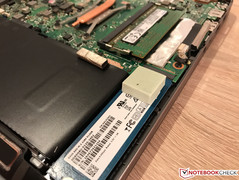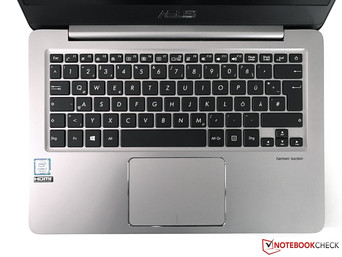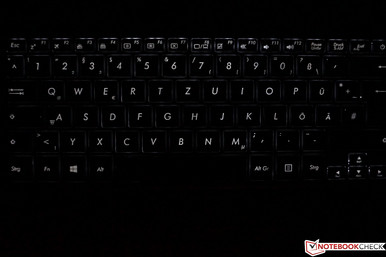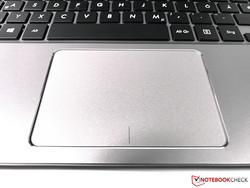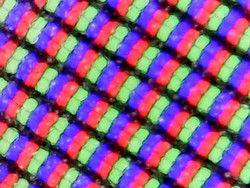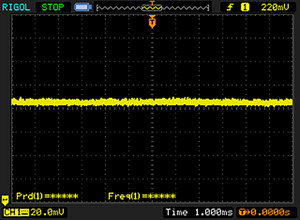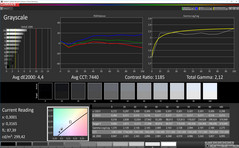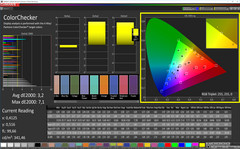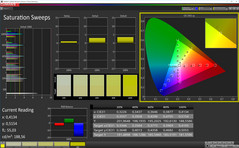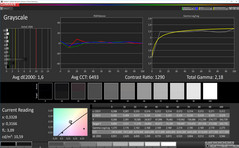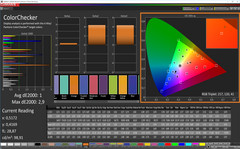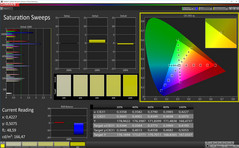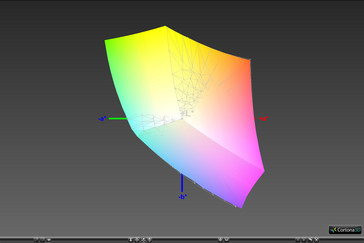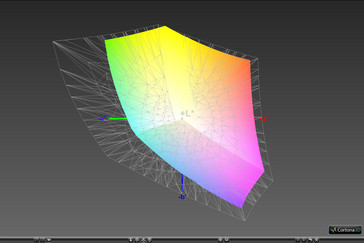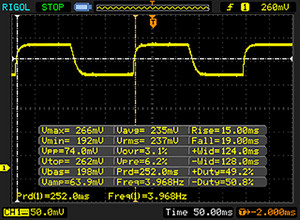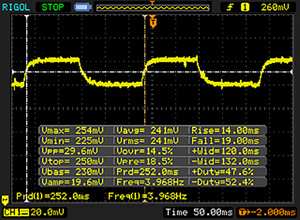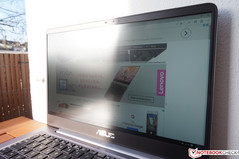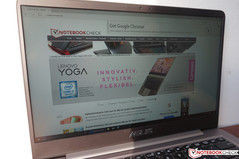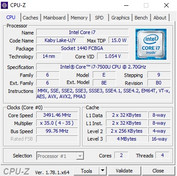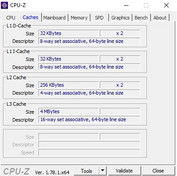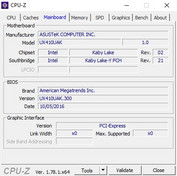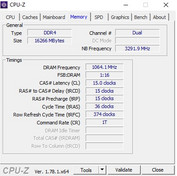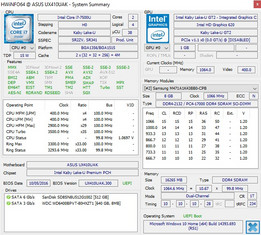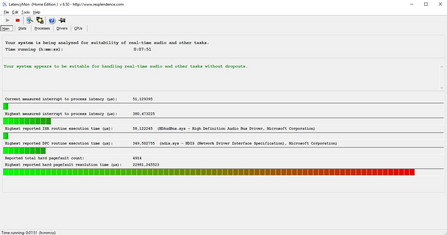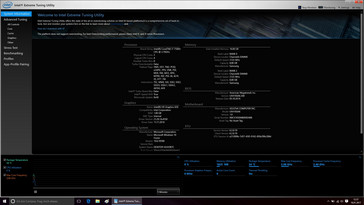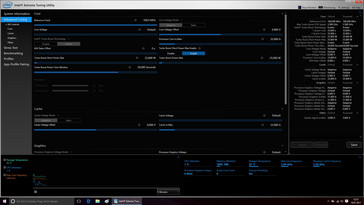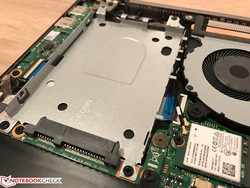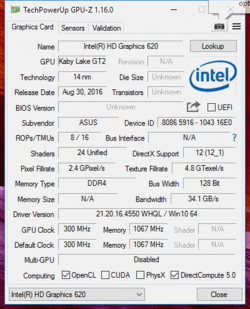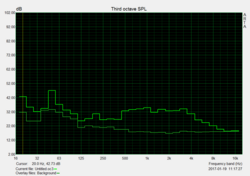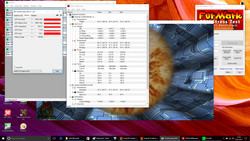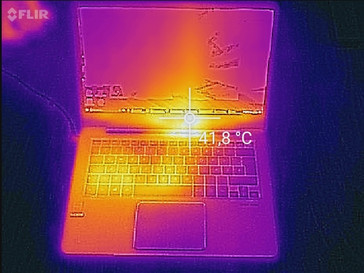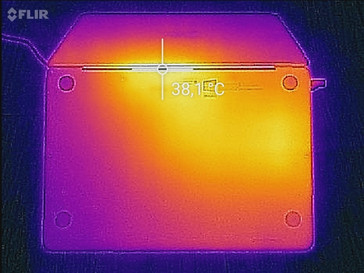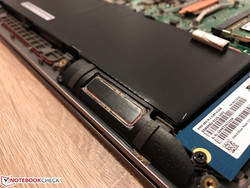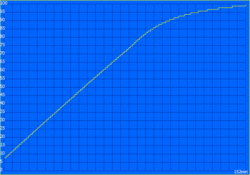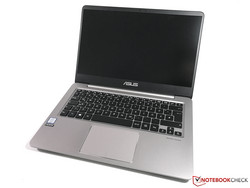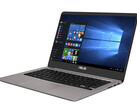Asus ZenBook UX3410UA Notebook Review

For the original German review, see here.
Asus now also offers a system with a 14-inch screen. It is called ZenBook UX3410UA, which is a bit confusing at first, because you would usually expect a "4" at the beginning of the product number. However, Asus took the casing of the ZenBook UX310UQ (here in review) and put a larger screen in it, which is clearly noticeable when you see the thin bezels. You can therefore still enjoy the advantages of the compact and light 13-inch case.
We had the exclusive opportunity to review the new ZenBook ahead of the official launch. Our test model with the designation UX3410UA-GV078T is equipped with a modern Kaby Lake Core i7 processor, a 512 GB SSD and 16 GB DDR4-RAM. The display is a matte Full HD IPS screen. Asus also offers another configuration (UX3410UQ-GV077T) with a dedicated Nvidia GeForce 940MX, SSD/HDD combination (also Core i7 and 16 GB DDR4-RAM). Both models are available right now for 1,199 Euros (~$1286, RRP). There are also supposed to be entry-level models of the UX3410 with prices starting at 899 Euros (~$964), but we have no information about the specs so far.
Competitors for the ZenBook UX3410UA are devices like the Acer Swift 5, Acer TravelMate X3 or the Lenovo Yoga 710. Another rival is obviously the 13.3-inch ZenBook UX310UQ. It is also a good indicator for the performance of the (optional) dedicated graphics card and we can see the effects of the larger panel in different sections.
Case
The design of the ZenBook UX3410UA does not differ from the ZenBook UX310UQ we already reviewed. Asus uses an aluminum chassis in the colors Quartz Gray or Rose Gold (keyboard and display bezels black). The most unique feature of the ZenBooks is the concentric circle pattern on the lid. The design is very appealing in general, only the lid attracts fingerprints quite easily.
The stability of the compact laptop is also convincing. Basically, we cannot twist the base unit even with a lot of force and there are no creaking sounds, either. The only weak spot is the center keyboard area towards the hinge, which can be pushed in a bit. However, this is not a problem in practice. We are not completely happy with the central hinge. The resistance is okay and it is possible to open the lid with one hand, but the screen bounces quite quickly and the maximum opening angle is also limited at just 120-125 degrees.
However, we are positively surprised by the lid, which is slightly thicker compared to the ZenBook UX310UQ. This improves the stability in particular, because we can neither provoke picture distortions nor twist it too much. All in all, the 14-inch panel works really well in the 13.3-inch chassis.
There is no maintenance hatch on the bottom, so you will have to remove the whole bottom cover to access the components (including the battery). More on that later.
Let's start with the comparison of the two ZenBooks. We already mentioned that the new ZenBook UX3410UA has a slightly thicker lid, but the footprint is identical to the regular UX310UQ. Our test model is a bit lighter, which is mainly a result of the missing mechanical hard drive.
All our comparison devices are pretty similar in terms of footprint, only the TravelMate X3 from Acer is a bit larger. However, one thing we notice is that the two ZenBooks are among the "thickest" systems at around 19 millimeters. It is still a very mobile and compact subnotebook in practice.
Connectivity
The port selection is identical to the smaller ZenBook UX310. Asus implements a total of four USB ports: 2x USB 2.0, 1x USB 3.0, 1x USB Type-C 3.1 (Gen.1) including DisplayPort (no Power Delivery). We did not expect two slow USB 2.0 ports on a laptop costing 1,200 Euros (~$1287). The transfer rates of the USB 3.0 port are decent at 280 MB/s in combination with our external Samsung SSD T3.
Users also get HDMI-out, a combined audio port as well as an SD-card reader. All ports are located at the sides to the back, so there should not be any problems with attached cables or devices, respectively. However, the ports are very close to each other, so adjacent connectors might block each other. Some models of the UX3410 will also be equipped with a fingerprint scanner.
SD-Card Reader
The integrated card reader does not manage good transfer rates. Similar to the Asus ZenBook UX310, we can only measure up to around 39 MB/s in combination with our reference card from Toshiba (Exceria Pro M401, 64 GB); a 1 GB folder with pictures (~5 MB each) is copied to the notebook at only around 33 MB/s. Especially photographers will have to consider this. A continuous storage expansion is not only prevented by the performance, because about two-thirds of the card protrudes from the chassis.
| SD Card Reader | |
| average JPG Copy Test (av. of 3 runs) | |
| Acer Swift 5 SF514-51-59AV | |
| Lenovo Yoga 710-14IKB 80V4002HGE | |
| Asus Zenbook UX310UQ-GL011T | |
| Asus Zenbook UX3410UA | |
| Acer TravelMate X3 X349-M-7261 | |
| maximum AS SSD Seq Read Test (1GB) | |
| Acer Swift 5 SF514-51-59AV | |
| Lenovo Yoga 710-14IKB 80V4002HGE | |
| Asus Zenbook UX310UQ-GL011T | |
| Asus Zenbook UX3410UA | |
| Acer TravelMate X3 X349-M-7261 | |
Communication
Wireless network connections are handled by a Wi-Fi module from Intel with the designation Dual-Band Wireless-AC 8260 (2x2). It supports all common standards including the fast 802.11ac in 2.4 as well as 5 GHz networks. The maximum transfer rate is 867 Mbps, and we can determine 323 Mbps (receive) and 469 Mbps (send) in our standardized WLAN test with the router Linksys EA8500. Other laptops manage better results, but there are no limitations in real-world applications. Intel's WiDi (Wireless Display) as well as Bluetooth 4.2 are also supported by the module and Asus integrates a Trusted Platform Module 2.0.
Above the display is an HD webcam surrounded by two microphones. The latter work well, but the webcam (videos up to 1280x720 @30 fps) has problems with picture noise even in good lighting conditions and fast movements are not captured well, either. Unlocking the device via facial recognition (Windows Hello) is not supported.
Software
Asus ships the ZenBook with Windows 10 Home 64-bit. Our early production sample uses a rather outdated version though, and we had to install two major updates (1511 & 1611). There are also some preloaded applications (see screenshot on the right). This includes the usual trial versions like Office 365 and McAfee LiveSafe as well as handy things like DropBox (including 25 GB storage for 6 months), but also unnecessary stuff like the WildTangent Games App.
The Asus BIOS is nicely designed (accessible via F2 during boot), but the navigation with the touchpad was very tricky. It was much more comfortable to use the keys. There are some options in the BIOS (like installing passwords), but obviously you cannot expect comprehensive settings like you find in a business notebook.
Accessories
Maintenance
There are no maintenance hatches, so you have to remove the whole bottom panel to access the components. It is secured by a total of 12 screws: 10 visible Torx screws (T4) and two Philips screws underneath the two rear support feet. It is pretty easy to lift the panel once all the screws are loosened.
Both the processor as well as 8 GB RAM are soldered onto the motherboard. There is an additional SODIMM-slot, which is equipped with an 8 GB module by default. The maximum amount of RAM is therefore 24 GB with a 16 GB module. The M.2-SSD (2280), the WLAN module, and the fan are accessible as well. The empty 2.5-inch slot is a handy feature if you want to implement another hard drive or SSD. You can also see the position of the optional dedicated GPU in the center.
Warranty
Asus grants a two-year warranty for the ZenBook UX3410UA including a Pickup & Return service.
Please see our Guarantees, Return Policies & Warranties FAQ for country-specific information.
Input Devices
Keyboard
The black chiclet keyboard offers ample key travel of 1.6 mm, but the keys tilt a bit towards the side, which results in a slightly spongy feedback. However, you will get used to that after a while and the typing experience is comfortable in general. The layout does not offer any surprises, only the small directional keys are not perfect.
Typing in dark environments benefits from the three-stage white background illumination, which is a bit dazzling underneath the keys depending on your position. It is automatically deactivated when you do not use the keyboard for a minute, and we did not find any settings to change/deactivate it.
Touchpad
The mouse replacement is called Asus Precision Touchpad and is implemented as a ClickPad without dedicated buttons. You can click the whole lower part instead, which produces a steady, but a bit loud feedback on both sides. The smooth surface is sufficiently sized at 10.5 x 7.5 cm and multi-touch gestures are supported with up to four fingers. The handling benefits from the good gliding capabilities and we did not have any problems during our review. Asus also provides an app for handwritten inputs. However, the system only recognizes single letters or digits, so the practical benefits are limited.
Display
The biggest difference between the test model and the ZenBook UX310 is obviously the larger 14-inch screen. Asus uses Full HD panels with a matte surface for the two configurations. Contrary to the UX310, the Chi Mei CMN14D2 (N140HCE-EN1) is an IPS display with WLED background illumination.
We think the resulting pixel density (157 PPI) results in a very good compromise between sharpness, screen estate, and power consumption. Subjectively, we like the rich colors, the bright display and the crisp images. Asus does not use PWM to adjust the luminance and we cannot determine backlight bleeding, either. Asus also implemented a brightness sensor, which can adjust the luminance automatically. It is handy that you can easily activate/deactivate the sensor with the key combination Fn + "A".
Screen Flickering / PWM (Pulse-Width Modulation)
| Screen flickering / PWM not detected | |||
In comparison: 53 % of all tested devices do not use PWM to dim the display. If PWM was detected, an average of 8081 (minimum: 5 - maximum: 343500) Hz was measured. | |||
| |||||||||||||||||||||||||
Brightness Distribution: 87 %
Center on Battery: 376 cd/m²
Contrast: 1175:1 (Black: 0.32 cd/m²)
ΔE ColorChecker Calman: 3.2 | ∀{0.5-29.43 Ø4.77}
ΔE Greyscale Calman: 4.4 | ∀{0.09-98 Ø5}
98.98% sRGB (Argyll 1.6.3 3D)
63.78% AdobeRGB 1998 (Argyll 1.6.3 3D)
69.4% AdobeRGB 1998 (Argyll 3D)
99.1% sRGB (Argyll 3D)
67.7% Display P3 (Argyll 3D)
Gamma: 2.12
CCT: 7440 K
| Asus Zenbook UX3410UA ChiMei N140HCE-EN1, , 1920x1080, 14" | Asus Zenbook UX310UQ-GL011T AU Optronics AUO142D, , 1920x1080, 13.3" | Acer Swift 5 SF514-51-59AV AU Optronics B140HAN3.2, , 1920x1080, 14" | Acer TravelMate X3 X349-M-7261 AU Optronics B140HAN02.1, , 1920x1080, 14" | Lenovo Yoga 710-14IKB 80V4002HGE AU Optronics B140HAN03.0, , 1920x1080, 14" | |
|---|---|---|---|---|---|
| Display | -10% | -7% | -45% | -9% | |
| Display P3 Coverage (%) | 67.7 | 61.9 -9% | 62.8 -7% | 36.97 -45% | 62 -8% |
| sRGB Coverage (%) | 99.1 | 88.3 -11% | 91.3 -8% | 55.6 -44% | 89.5 -10% |
| AdobeRGB 1998 Coverage (%) | 69.4 | 63 -9% | 64.3 -7% | 38.2 -45% | 63.3 -9% |
| Response Times | 6% | -19% | -5% | -29% | |
| Response Time Grey 50% / Grey 80% * (ms) | 33 ? | 39 ? -18% | 51 ? -55% | 42 ? -27% | 53 ? -61% |
| Response Time Black / White * (ms) | 34 ? | 24 ? 29% | 28 ? 18% | 28 ? 18% | 33 ? 3% |
| PWM Frequency (Hz) | 50 ? | 50 ? | |||
| Screen | -26% | -22% | -21% | -34% | |
| Brightness middle (cd/m²) | 376 | 247 -34% | 393 5% | 230 -39% | 340 -10% |
| Brightness (cd/m²) | 355 | 240 -32% | 338 -5% | 226 -36% | 302 -15% |
| Brightness Distribution (%) | 87 | 90 3% | 79 -9% | 86 -1% | 77 -11% |
| Black Level * (cd/m²) | 0.32 | 0.43 -34% | 0.29 9% | 0.2 37% | 0.31 3% |
| Contrast (:1) | 1175 | 574 -51% | 1355 15% | 1150 -2% | 1097 -7% |
| Colorchecker dE 2000 * | 3.2 | 4.74 -48% | 6.17 -93% | 5.07 -58% | 6.75 -111% |
| Colorchecker dE 2000 max. * | 7.1 | 9.14 -29% | 11.21 -58% | 10.07 -42% | 12.4 -75% |
| Greyscale dE 2000 * | 4.4 | 4.87 -11% | 6.8 -55% | 3.64 17% | 8.47 -93% |
| Gamma | 2.12 104% | 2.57 86% | 2.27 97% | 2.46 89% | 2.22 99% |
| CCT | 7440 87% | 7450 87% | 6873 95% | 6521 100% | 6557 99% |
| Color Space (Percent of AdobeRGB 1998) (%) | 63.78 | 57 -11% | 51 -20% | 35 -45% | 58 -9% |
| Color Space (Percent of sRGB) (%) | 98.98 | 88 -11% | 91 -8% | 55 -44% | 89 -10% |
| Total Average (Program / Settings) | -10% /
-18% | -16% /
-19% | -24% /
-24% | -24% /
-28% |
* ... smaller is better
Our display measurements show a very good maximum luminance of 380 nits. The average is still 355 nits, but the brightness distribution of 87% could be a bit better. You cannot see the differences with the naked eye though. The panel manages a low black value of 0.32 cd/m² despite the high luminance, which is also available on battery power. A contrast ratio of almost 1200:1 is a very good result for the ZenBook UX3410, and it is almost twice as high compared to the TN panel of the ZenBook UX310.
The color temperature is a bit too cool ex-works at around 7500 K (ideal: 6500 K) and there is also a slight blue cast. The average DeltaE-2000 deviations compared to the sRGB color space are already very decent without calibration. The target value is smaller than 3, which is just slightly missed by the ColorChecker at 3.2 (up to 7.1). The situation is not much worse for the grayscale at 4.4. The Asus Splendid Technology pays off here, and it also offers several picture modes. There is an EyeCare profile (reduction of blue colors), Vivid, and Manual (manual adjustment of the color temperature).
We can clearly improve the performance with calibration. The blue cast is gone and the color temperature is very close to its ideal value at 6455 K, which is also the case for the gamma value at 2.18 (ideal: 2.2). The average DeltaE-2000 deviations for the colors (1.0) as well as the grayscale (1.6) also drop below 3. That the display is actually suited for picture editing is also supported by the almost full sRGB coverage, and the wider AdobeRGB gamut is covered by 64%. We linked the .icc file of the calibrated display in the box above and you can use it for free.
Display Response Times
| ↔ Response Time Black to White | ||
|---|---|---|
| 34 ms ... rise ↗ and fall ↘ combined | ↗ 15 ms rise | |
| ↘ 19 ms fall | ||
| The screen shows slow response rates in our tests and will be unsatisfactory for gamers. In comparison, all tested devices range from 0.1 (minimum) to 240 (maximum) ms. » 90 % of all devices are better. This means that the measured response time is worse than the average of all tested devices (20.2 ms). | ||
| ↔ Response Time 50% Grey to 80% Grey | ||
| 33 ms ... rise ↗ and fall ↘ combined | ↗ 14 ms rise | |
| ↘ 19 ms fall | ||
| The screen shows slow response rates in our tests and will be unsatisfactory for gamers. In comparison, all tested devices range from 0.165 (minimum) to 636 (maximum) ms. » 44 % of all devices are better. This means that the measured response time is similar to the average of all tested devices (31.6 ms). | ||
The matte panel and the high luminance are great for the outdoor capabilities. The ZenBook UX3410 does not disappoint, because you can also use the notebook very well in sunlight as long as you avoid reflections from direct light sources (see picture below). The viewing-angle stability of the IPS screen is also very good. We can only notice a slightly paler picture from an angle from above, but multiple people can still look at the screen simultaneously without any limitations.
Performance
The Asus ZenBook UX3410UA is a powerful subnotebook for private users. Thanks to its fast Core i7-7500U, 512 GB SSD, and 16 GB DDR4-RAM in a dual-channel configuration, the system can be used for mails and web browsing and also for more demanding scenarios like picture or video editing. You should have a look at the model with the dedicated Nvidia GeForce 940MX GPU if you like to play games.
Processor
Asus uses the ULV processor Core i7-7500U (TDP 15 Watts) from Intel's current Kaby Lake generation. The clocks are noticeably higher compared to the previous Skylake models thanks to an improved manufacturing process. The maximum Turbo Boost for one as well as two cores is now 3.5 GHz (base frequency 2.7 GHz) and the dual-core can execute up to four threads simultaneously thanks to Hyper-Threading.
Many ULV systems can increase the maximum power consumption for a short period, so the processor is better equipped to cover peak load. The Asus ZenBook UX3410 is no exception, but the manufacturer removes the time limit, so the processor can consume up to 25 Watts all the time, at least in theory. There is still a (pretty conservative) temperature limit at around 70 °C.
This results in very good benchmarks scores, because the full 3.5 GHz for both cores is maintained for a long time and the clock only drops to 3.3-3.4 GHz towards the end of the benchmarks. 368 points in the Cinebench R15 Multi test is at the top of the comparison group and it is therefore one of the fastest mobile dual-cores right now. The predecessor Core i7-6500U (Skylake) is beaten by around 13-14%, just like the slower Core i5-7200U. The competitors are closer in the Single Core test and the differences are limited to the single-digit range.
The usually passively cooled Core i processors with a TDP of 4.5 Watts (can be increased by the manufacturer), which are used in particularly slim devices, are another interesting comparison. One example is the Kaby Lake Core i5-7Y54 in the Acer Swift 7 running at 8.5 Watts. It falls behind by 22-44% depending on the test, which is perceptible in demanding applications.
There are more benchmarks for the Intel Core i7-7500U in our Tech section.
System Performance
The handling of the ZenBook UX3410UA is very good thanks to the fast components. The boot sequence in particular is very short and only takes a couple of seconds. Applications are quickly launched as well and the whole system is very responsive. This subjective impression is also supported by the PCMark 8 scores, because our test model is at the top of the comparison group.
| PCMark 8 | |
| Home Score Accelerated v2 | |
| Asus Zenbook UX3410UA | |
| Asus Zenbook UX310UQ-GL011T | |
| Acer TravelMate X3 X349-M-7261 | |
| Acer Swift 5 SF514-51-59AV | |
| Lenovo Yoga 710-14IKB 80V4002HGE | |
| Work Score Accelerated v2 | |
| Asus Zenbook UX3410UA | |
| Asus Zenbook UX310UQ-GL011T | |
| Acer TravelMate X3 X349-M-7261 | |
| PCMark 8 Home Score Accelerated v2 | 3965 points | |
| PCMark 8 Work Score Accelerated v2 | 5033 points | |
Help | ||
Storage Devices
Our test model of the ZenBook UX3410UA is equipped with a 512 GB SSD. The M.2-2280 drive from SanDisk (X400) is attached via SATA-III, so the transfer rates are limited at around 500 MB/s. We can also see these values in the benchmarks and the drive does not show any problems in general. You can use around 440 GB for your own files and applications ex-works.
Modern PCIe-NVMe SSDs manage much higher sequential transfer rates, but the differences are hardly noticeable in practice. The performance with small files is more important in this case, and the differences between SATA-III and NVMe drives are smaller in this respect.
The free 2.5-inch slot can be equipped with an additional storage drive (HDD or SSD) to expand the storage capacity. You can compare the performances of many solutions in our comprehensive SSD/HDD benchmark list.
| Asus Zenbook UX3410UA SanDisk SD8SN8U512G1002 | Asus Zenbook UX310UQ-GL011T SanDisk SD8SNAT256G1002 | Acer Swift 5 SF514-51-59AV SK Hynix HFS256G39TND-N210A | Acer TravelMate X3 X349-M-7261 Liteonit CV3-8D512 | Lenovo Yoga 710-14IKB 80V4002HGE Samsung MZYTY256HDHP | |
|---|---|---|---|---|---|
| CrystalDiskMark 3.0 | -18% | -6% | 8% | 3% | |
| Read Seq (MB/s) | 494.5 | 468.1 -5% | 517 5% | 484.1 -2% | 490.5 -1% |
| Write Seq (MB/s) | 461.7 | 319.2 -31% | 258.1 -44% | 449.8 -3% | 452.3 -2% |
| Read 512 (MB/s) | 328 | 318.6 -3% | 355 8% | 399.1 22% | 386.2 18% |
| Write 512 (MB/s) | 419.7 | 272.8 -35% | 258.5 -38% | 355.1 -15% | 219.9 -48% |
| Read 4k (MB/s) | 27.53 | 22.03 -20% | 29.65 8% | 33.44 21% | 34.35 25% |
| Write 4k (MB/s) | 56.5 | 72.1 28% | 77.3 37% | 67.5 19% | 91.2 61% |
| Read 4k QD32 (MB/s) | 351 | 147.4 -58% | 277.1 -21% | 368.5 5% | 378.9 8% |
| Write 4k QD32 (MB/s) | 249.3 | 200.2 -20% | 242.5 -3% | 280.6 13% | 152.2 -39% |
GPU Performance
The new graphics card from the Kaby Lake ULVs has the designation Intel HD Graphics 620. It is the GT2 version with 24 Execution Units and manages a core clock of up to 1050 MHz in combination with the Core i7. The GPU is not equipped with its own video memory, so it uses the system memory. Our test model uses fast DDR4 memory in a dual-channel configuration, which increases the GPU performance even further.
This is also supported by the benchmarks, where the HD Graphics 620 is among the fastest integrated graphics cards. Depending on the test, the HD Graphics 620 with single-channel RAM (DDR4, HP ProBook 430 G4) is beaten by 14-46%, and even the old Iris Graphics 540 with eDRAM is only a couple of percent faster in the current 3DMark.
The test model is slightly beaten by the entry-level GeForce 920MX when we compare the performance with dedicated GPUs. The optional GeForce 940MX (2 GB DDR3-VRAM) is around 50% faster depending on the test.
The graphics performance is not reduced on battery power. More benchmarks for the Intel HD Graphics 620 are available here.
| 3DMark 11 Performance | 1863 points | |
| 3DMark Cloud Gate Standard Score | 7237 points | |
| 3DMark Fire Strike Score | 1019 points | |
Help | ||
Gaming Performance
The HD Graphics 620 is powerful in our test model, but the overall performance is still only sufficient for older and less demanding titles like Tomb Raider of BioShock Infinite from 2013, for example. More modern games are often too challenging for the GPU and often cannot be played at all, even at low settings. Two examples are Rise of the Tomb Raider and The Witcher 3. If you plan on gaming, you should get the SKU with the dedicated Nvidia GeForce 940MX (UX3410UQ). More gaming benchmarks with the Intel HD Graphics are available in our Tech section.
| low | med. | high | ultra | |
|---|---|---|---|---|
| Tomb Raider (2013) | 100.1 | 47.2 | 29.4 | 13.5 |
| BioShock Infinite (2013) | 62.9 | 32.7 | 28.5 | 9.2 |
| Battlefield 4 (2013) | 49.2 | 32.9 | 23.6 | |
| The Witcher 3 (2015) | 15.8 | 10.3 | ||
| Rise of the Tomb Raider (2016) | 21.5 | 13.3 |
Emissions
System Noise
One fan takes care of the heat from the components – similar to the ZenBook UX310UQ. However, the fan of our test model is much more audible with light and medium workloads in particular. It will sometimes even start spinning while idling without apparent reason and reaches a very audible 35 dB(A) at around 3000 rpm. We can also measure higher values under load, despite the lack of a dedicated GPU, but the results can vary a bit depending on the scenario. Our measurement device shows more than 43 dB(A) both with medium as well as maximum load. This is too loud for this performance class; all the other comparison devices with iGPUs only reach up to 37 dB(A).
Considering the early state of our test sample, this behavior could be a result of non-optimized software. The fan does not create any inconvenient noises and also cools the processor well, so we do not think it is a hardware defect. We are already in contact with the manufacturer and will update this section as soon as we get new information.
Noise level
| Idle |
| 29.9 / 29.9 / 35.2 dB(A) |
| Load |
| 43.5 / 43.8 dB(A) |
 | ||
30 dB silent 40 dB(A) audible 50 dB(A) loud |
||
min: | ||
| Asus Zenbook UX3410UA i7-7500U, HD Graphics 620 | Asus Zenbook UX310UQ-GL011T 6500U, GeForce 940MX | Acer Swift 5 SF514-51-59AV i5-7200U, HD Graphics 620 | Acer TravelMate X3 X349-M-7261 6500U, HD Graphics 520 | Lenovo Yoga 710-14IKB 80V4002HGE i5-7200U, HD Graphics 620 | |
|---|---|---|---|---|---|
| Noise | 5% | 10% | 8% | 7% | |
| off / environment * (dB) | 29.9 | 30.5 -2% | 30.5 -2% | 31.15 -4% | 30.16 -1% |
| Idle Minimum * (dB) | 29.9 | 30.5 -2% | 30.5 -2% | 31.5 -5% | 30.16 -1% |
| Idle Average * (dB) | 29.9 | 30.5 -2% | 30.5 -2% | 31.5 -5% | 30.16 -1% |
| Idle Maximum * (dB) | 35.2 | 31.5 11% | 30.5 13% | 31.5 11% | 30.5 13% |
| Load Average * (dB) | 43.5 | 36.2 17% | 32.25 26% | 31.7 27% | 37.2 14% |
| Load Maximum * (dB) | 43.8 | 40 9% | 32.6 26% | 34.1 22% | 37 16% |
* ... smaller is better
Temperature
The ZenBook UX3410UA is a very cool device and basically does not warm up at all while idling and with light workloads. The warming under load is mainly focused at the top of the base unit around the cooling and the heat pipe, but up to 39.4 °C during the stress test is anything but problematic. We can only measure a little more than 35 °C at the bottom, so you can use it on your lap very comfortably.
The SoC will quickly reach the temperature limit of 70 °C where the TDP limit (15 Watts) sets in when we stress both components. We can only see the maximum core clocks for a couple of seconds in our stress test with the tools Prime95 and FurMark before the SoC reaches 76 °C. The CPU clock will level off at around 1.7 GHz (base frequency 2.7 GHz) after that, while the GPU still runs at 1000-1050 MHz. The situation changes a bit on battery. The processor has a higher clock (~2.8 GHz), but the GPU drops to just 450 MHz. A 3DMark 11 run immediately after the stress test did not result in a lower score, so there should not be any limitations in practical load scenarios.
The compact plug-in power adapter (45 Watts) can get quite warm under load. We can measure almost 50 °C in an extreme scenario (charging of the battery + load), but around 44-45 °C under load when the battery is fully charged.
(+) The maximum temperature on the upper side is 39.4 °C / 103 F, compared to the average of 35.9 °C / 97 F, ranging from 21.4 to 59 °C for the class Subnotebook.
(+) The bottom heats up to a maximum of 35.2 °C / 95 F, compared to the average of 39.3 °C / 103 F
(+) In idle usage, the average temperature for the upper side is 28.1 °C / 83 F, compared to the device average of 30.8 °C / 87 F.
(+) The palmrests and touchpad are cooler than skin temperature with a maximum of 31.5 °C / 88.7 F and are therefore cool to the touch.
(-) The average temperature of the palmrest area of similar devices was 28.2 °C / 82.8 F (-3.3 °C / -5.9 F).
Speakers
Two stereo speakers are located at the front edge and direct the sound downwards at a 45 ° angle. The sound will be reflected towards the user on solid surfaces, but the result can be a bit muffled on soft surfaces (lap, couch, etc.). Our measurements show very linear mids and high tones as well as a decent maximum volume of almost 79 dB(A). However, we are still not really convinced by the result, mainly because of the missing bass. Subjectively, movies and music just lack power.
Asus installs the AudioWizard, which offers some presets (Movie, Music, Voice, Game, Voice Recording), but manual adjustments are not possible. The performance is obviously sufficient for some YouTube videos or some background music, but you should use external speakers or headphones for a better audio performance. The stereo jack is inconspicuous in this respect and the connection to our Bluetooth speaker (Denon Envaya Mini) was established without any problems and was very stable.
Asus Zenbook UX3410UA audio analysis
(±) | speaker loudness is average but good (78.9 dB)
Bass 100 - 315 Hz
(-) | nearly no bass - on average 17.2% lower than median
(±) | linearity of bass is average (10.2% delta to prev. frequency)
Mids 400 - 2000 Hz
(+) | balanced mids - only 2.3% away from median
(+) | mids are linear (4.1% delta to prev. frequency)
Highs 2 - 16 kHz
(+) | balanced highs - only 4.7% away from median
(+) | highs are linear (2.4% delta to prev. frequency)
Overall 100 - 16.000 Hz
(±) | linearity of overall sound is average (17.3% difference to median)
Compared to same class
» 43% of all tested devices in this class were better, 9% similar, 47% worse
» The best had a delta of 5%, average was 18%, worst was 53%
Compared to all devices tested
» 32% of all tested devices were better, 8% similar, 60% worse
» The best had a delta of 4%, average was 24%, worst was 134%
Acer Swift 5 SF514-51-59AV audio analysis
(-) | not very loud speakers (66 dB)
Bass 100 - 315 Hz
(±) | reduced bass - on average 14.7% lower than median
(±) | linearity of bass is average (13.5% delta to prev. frequency)
Mids 400 - 2000 Hz
(±) | higher mids - on average 5.3% higher than median
(±) | linearity of mids is average (7.3% delta to prev. frequency)
Highs 2 - 16 kHz
(+) | balanced highs - only 3.9% away from median
(±) | linearity of highs is average (8.1% delta to prev. frequency)
Overall 100 - 16.000 Hz
(±) | linearity of overall sound is average (22% difference to median)
Compared to same class
» 74% of all tested devices in this class were better, 6% similar, 20% worse
» The best had a delta of 5%, average was 18%, worst was 53%
Compared to all devices tested
» 63% of all tested devices were better, 6% similar, 31% worse
» The best had a delta of 4%, average was 24%, worst was 134%
Frequency comparison (checkboxes are selectable/deselectable)
Energy Management
Power Consumption
The ZenBook UX3410 is a very efficient system while idling and with light workloads, because we can only measure 3.7 up to 6.8 Watts. The keyboard illumination will draw another Watt. The results are also good within our comparison group.
We can see the effect of the increased TDP limit under load. Our measurement device indicates little more than 47 Watts at the start of the stress test, despite the integrated GPU. The consumption will level off at around 37 Watts after ~1 minute. The provided 45-Watt power adapter is therefore sufficient, but it does not have a lot of headroom to charge the battery under load. A full recharge of the battery takes 2.5 hours when the system is turned on, although 50% of the capacity is already available after 50 minutes.
| Off / Standby | |
| Idle | |
| Load |
|
Key:
min: | |
| Asus Zenbook UX3410UA i7-7500U, HD Graphics 620, 1920x1080, 14" | Asus Zenbook UX310UQ-GL011T 6500U, GeForce 940MX, 1920x1080, 13.3" | Acer Swift 5 SF514-51-59AV i5-7200U, HD Graphics 620, 1920x1080, 14" | Acer TravelMate X3 X349-M-7261 6500U, HD Graphics 520, 1920x1080, 14" | Lenovo Yoga 710-14IKB 80V4002HGE i5-7200U, HD Graphics 620, 1920x1080, 14" | |
|---|---|---|---|---|---|
| Power Consumption | -8% | -4% | -8% | 3% | |
| Idle Minimum * (Watt) | 3.7 | 3 19% | 3.6 3% | 4.9 -32% | 3.7 -0% |
| Idle Average * (Watt) | 6 | 5.6 7% | 7 -17% | 7.3 -22% | 7.16 -19% |
| Idle Maximum * (Watt) | 6.78 | 6.8 -0% | 9.3 -37% | 9.4 -39% | 8.3 -22% |
| Load Average * (Watt) | 37.3 | 48.7 -31% | 37 1% | 26 30% | 30.4 18% |
| Load Maximum * (Watt) | 47.4 | 63 -33% | 32.6 31% | 36 24% | 30.3 36% |
* ... smaller is better
Battery Runtime
The ZenBook UX3410 is equipped with a 3-cell battery (lithium-ion) and a capacity of 48 Wh, so all the comparison devices (48-53 Wh) are in the same ballpark. We were obviously eager to see the impact of the larger screen.
In short: it is small. Our practical WLAN test at an adjusted luminance of 150 nits (58% for our test model) and the Windows power profile "Balanced" determines a good runtime of 7:23 hours – only 40 minutes shorter compared to the ZenBook UX310. A loop of our test video Big Buck Bunny (H.264, FHD) even runs for 10 hours (150 nits, power-saver, wireless turned off). These results are also good within our comparison group. Only the Acer Swift 5 and the Lenovo Yoga 710 last around 1.5 hours longer in the WLAN test.
The ZenBook UX3410UA has to be recharged after just 98 minutes under load (High Performance power profile). The competition lasts a bit longer, but they also have darker screens and slightly slower processors in return. We determine the maximum runtime with the Battery Eater Reader's Test. The ZenBook runs for almost 18 hours with the power-saver profile and the minimum luminance.
| Asus Zenbook UX3410UA i7-7500U, HD Graphics 620, 48 Wh | Asus Zenbook UX310UQ-GL011T 6500U, GeForce 940MX, 48 Wh | Acer Swift 5 SF514-51-59AV i5-7200U, HD Graphics 620, 53.9 Wh | Acer TravelMate X3 X349-M-7261 6500U, HD Graphics 520, 48.9 Wh | Lenovo Yoga 710-14IKB 80V4002HGE i5-7200U, HD Graphics 620, 53 Wh | |
|---|---|---|---|---|---|
| Battery runtime | -9% | 4% | -17% | 9% | |
| Reader / Idle (h) | 17.7 | 14.6 -18% | 16.9 -5% | 11.3 -36% | 16 -10% |
| H.264 (h) | 10.1 | 7 -31% | 9.3 -8% | 6.7 -34% | 8.7 -14% |
| WiFi v1.3 (h) | 7.4 | 8.1 9% | 9.2 24% | 6.5 -12% | 9.4 27% |
| Load (h) | 1.6 | 1.7 6% | 1.7 6% | 1.8 13% | 2.1 31% |
Pros
Cons
Verdict
The new Asus ZenBook UC3410UA follows the trend to use a larger display. The 14-inch panel works very well inside the 13.3-inch chassis and there are no negative aspects compared to the regular ZenBook UX310 except for the slightly shorter Wi-Fi runtime. Quite the contrary: The stability is even better thanks to the slightly thicker lid and the great IPS display easily surpasses the TN screen of the UX310 in every way.
The ZenBook UX3410UA is even more appealing with the larger screen. Asus also uses a very good matte FHD-IPS panel.
The ZenBook can also convince in many other sections. The aluminum casing is sophisticated and sturdy, the performance utilization of the processor is very good, and the input devices are decent as well. Offering four USB ports is laudable, but we do not expect slow USB 2.0 ports on a device that costs 1,200 Euros (~$1287). The integrated card reader is not a fast model, either.
We are less convinced by the fan, which can be quite loud and also starts to spin with light workloads. This is perhaps related to our early test sample, and we hope that a software update will improve the situation. The identical cooling solution is at least noticeably quieter in the regular ZenBook UX310UQ, despite the dedicated graphics card.
Asus Zenbook UX3410UA
- 01/20/2017 v6 (old)
Andreas Osthoff


